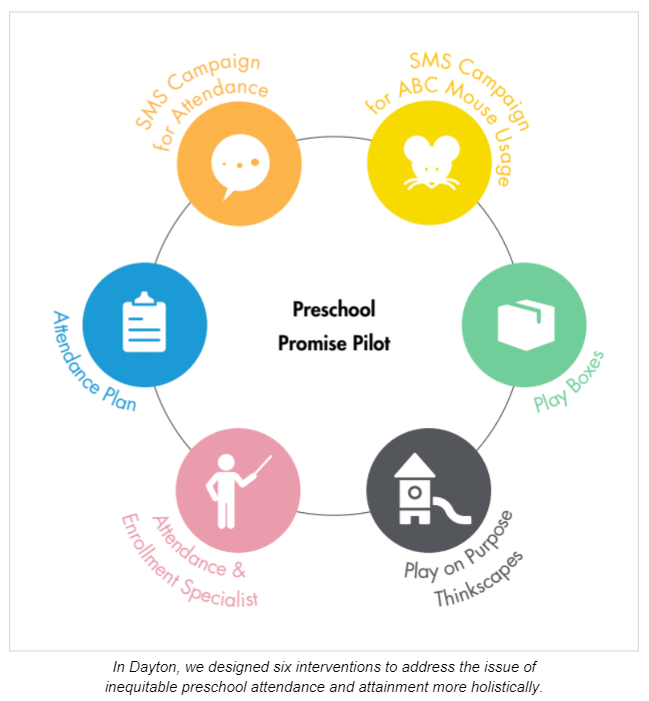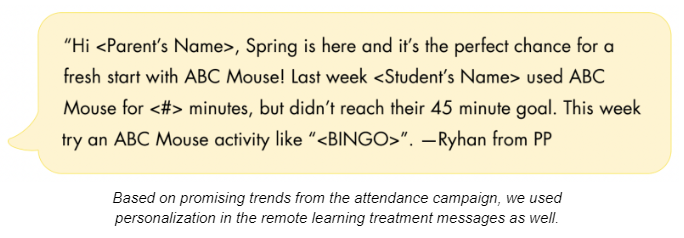Increasing economic mobility is a complex challenge for cities. Many factors have an effect. Employment, housing, and health care are just a few. While these areas are critical, cities should also start addressing economic mobility barriers as early as preschool.
Dayton, OH understands the need to act early. Ensuring that all children have access to high-quality early childhood education is a critical part of its economic mobility strategy. In 2016, Daytonians voted for a 0.25% income tax increase to strengthen city services, including offering one year of affordable, quality preschool to all four-year-olds. This funding established Preschool Promise, a nonprofit that equips preschools and families with exceptional support and education to prepare kids for kindergarten.
In 2019, Dayton joined Bloomberg Philanthropies’ What Works Cities Economic Mobility Initiative, along with eight other cities in an innovative cohort. BIT and Results for America (RFA) partnered with the city and Preschool Promise to enhance preschool attendance, engagement, and enrollment.
We found that a personalized feedback intervention boosted engagement with remote learning by more than 50%. We also saw promising evidence suggesting that similar feedback could improve in-person attendance rates.
Aiming to Close the Attendance Gap
Like economic mobility, increasing preschool attendance requires a holistic effort. Many barriers affect whether a child gets to school regularly (ie nine out of 10 school days or more) and on time. Caregivers may not prioritize early childhood education or understand its long term benefits. Structurally, a lack of transportation can prevent getting kids to school, while a lack of quality early learning materials at home or in the neighborhood may affect educational attainment.
Thanks to the leadership of Mayor Nan Whaley, City Manager Shelley Dickstein, and Robyn Lightcap, Executive Director of Preschool Promise, Dayton already has outstanding preschool programming. However, before the COVID-19 pandemic, the city struggled with differences in attendance rates based on race. During the 2018–2019 school year, while two-thirds of the city’s white preschoolers met the ideal minimum attendance rate, only 62% of Black girls and just over half of Black boys had similarly high attendance rates.
Our initial priority was to help close this attendance gap. But when the pandemic hit in the middle of our first trial, we pivoted and designed a system of interventions to address the myriad barriers to attainment.

By evaluating multiple interventions, we were able to help the city identify and invest in strategies that work. In particular, two SMS campaigns showed promising results for increasing attendance and engagement.
Developing an SMS campaign to boost attendance
Before the pandemic, we designed an SMS campaign urging caregivers to bring their kids to preschool regularly.
Two hundred and seventy parents participated in a randomized controlled trial in which they received different types of messages. Parents in the treatment group received a personalized text every Wednesday and on special occasions (eg holidays or snow days) encouraging attendance. Personalized messages included the recipient’s and student’s names. They were also tailored with information about the child’s recent attendance rate. The control group received monthly messages that encouraged preschool attendance generally.

Though this study had to be cut short due to the pandemic, we found a promising trend. Families in the treatment group had a higher proportion of students who met or surpassed the 90% attendance goal compared to those in the control group.
Increasing at-home learning during the pandemic
Encouraging in-person attendance was no longer feasible or desirable once pandemic stay-at-home orders took effect. Preschools temporarily closed and educators moved to a remote learning format.
Preschool Promise quickly responded with a series of new, high-quality learning tools for parents and caregivers to use at home. They sent families with enrolled preschoolers a free tablet with a personalized subscription to ABC Mouse, an online education program that promotes early literacy and numeracy, plus a monthly Play Box containing a book and interactive learning activities. To maximize the benefits of ABC Mouse, families were encouraged to use the program for at least 45 minutes a week.
Building on insights from the SMS attendance campaign trial, we shifted our SMS campaign to increase families’ engagement with ABC Mouse. We developed two new sets of behaviorally-informed text messages: a standard one that simply encouraged recipients to use the program, and a personalized one that included information about individual usage from the previous week.

Between December 2020 and May 2021, 671 families participated in a randomized controlled trial to determine which type of SMS was more effective. We found that families who received the personalized messages used ABC Mouse 50% more than the standard message recipients. Our analysis suggests that personalized messages are more effective, but unfortunately, neither group consistently hit the 45-minute per week goal.
A System of Behavioural Interventions[h2]
In addition to the SMS campaigns, we designed four other interventions to increase attendance and attainment during our 18-month partnership.
Highlights included helping Preschool Promise hire their first Attendance & Enrollment Specialist, whose responsibilities were to make it easy for families to enroll and troubleshoot barriers to attendance. When the pandemic hit, they shifted to support remote learning. Preschool Promise plans to continue this role full-time.
We also developed an Attendance Plan to help facilitate conversations between teachers and parents. The plan aligned expectations around attendance and served as an accountability tool for parents to commit to a 90% attendance rate. The Attendance Plans were paused at the outset of the pandemic, but there are plans to bring them back once classroom learning returns. For more on our work with Dayton—Play Boxes, Thinkscapes, and more—read the full memo here.
Approaching the Problem Holistically and applying Behavioural Insights from many angles
Our partnership with Dayton was meaningful for many reasons. The city and its partners, like Preschool Promise and the University of Dayton, are committed to collecting the right data, bringing in expert collaborators, and developing a strong theory of change to make high-quality preschool accessible to all eligible children.
Often BIT is asked to focus on only one aspect of a challenge. This work with early childhood education shows the potential of approaching a problem more holistically. By applying behavioral insights from many different angles to enhance city programs and adapt to new and unforeseen challenges, we were able to make tangible progress in advancing economic mobility for the future of Dayton.
To explore partnering with BIT on early childhood education projects, please contact us here.






